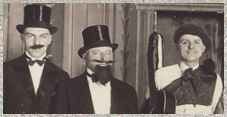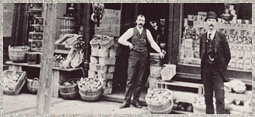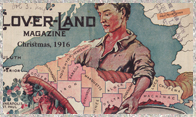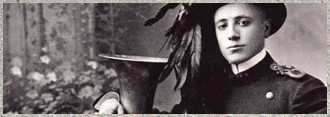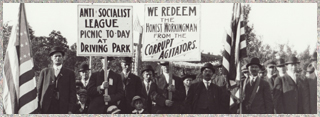Using Primary Sources to Teach Critical Thinking Skills in Historical Research: A Set of Lesson Plans for High School Social Studies Teachers
Prepared by: Marcus C. Robyns, CA, Associate Professor / University Archivist & Robin Kennedy, Project Archivist
Central Upper Peninsula and Northern Michigan University Archives
Introduction
Teaching students to think critically is a major component of the curriculum in public education, and educators are familiar with the importance of using primary sources in the classroom. Indeed, Michigan has incorporated critical thinking concepts and skills into its Michigan Curriculum Framework as part of the Michigan Educational Assessment Program (MEAP). Under standard 1.3, Analyzing and Interpreting the Past, for instance, Michigan educators expect students to “reconstruct the past by comparing interpretations written by others from a variety of perspectives and creating narratives from evidence.” The standard acknowledges research as a process of information gathering from a variety of sources in many different formats. However, by high school the state expects that students have moved beyond information gathering toward a demonstrated “ability to interpret the meaning and significance of data.” The framework recognizes the subjective nature of primary sources and appreciates the need for rigorous critical review during the research process.[1]
The three lesson plans in this packet use original documents from the Dominic Jacobetti papers, the Charles Varnum papers, and the Pat Gagliardi papers maintained by the Central Upper Peninsula and Northern Michigan University Archives. Each collection documents the remarkable political career of these three politicians from the Upper Peninsula of Michigan. Instruction should begin with an in-class discussion that covers the following principle components:
What is Historical Research?
What are Primary Sources?
What is Critical Thinking?
This introduction concludes with a set of recommended readings.
1) What Is Historical Research?
Students of the humanities should be encouraged to think of archives as a lab much the same way students in the hard sciences use a chemistry or physics lab to gather evidence to support a hypothesis. The term historical research connotes a vast set of complex methodologies used by the professional historian; however, for purposes of this exercise, the discussion of historical research should focus on the process by which a researcher selects the most verifiable and credible evidence from a collection of primary sources. Historical research begins with a set of historical problems or questions that must be answered during the course of analysis and interpretation of the evidence. As the researcher moves through the process, the evidence guides the researcher toward the formulation of a thesis.
2) What are Primary Sources?
Before a student tackles a primary source, it is essential that he/she has a solid understanding of what is a primary source. This is no easy task, since there are many definitions. In general, a primary source is a record of an event, function, or activity contemporary to the time period under consideration. Under this definition, a primary source could be a letter, a memorandum, a report, a newspaper account, an arrest record, or a diary. However, for the purpose of this exercise, the instructor should emphasize that a primary source is a witness’s recorded observations an event or activity. In this way, the instructor can stress that a primary source is subjective in nature, requiring the application of critical thinking skills in its analysis. Conal Furay and Michael J. Salevouris wrote that primary sources can
mislead, lie, or lure you into a false sense of security. They can be written in the obscure languages of the ancients or the incomprehensible jargon of the modern bureaucrat. They can lead the researcher into blind alleys, false turns, and dead ends . . . The historian is a detective; the primary sources are the clues.[2]
Primary sources are the clues that lead to the determination of the truth in an historical event. Because of human fallibility, an observer’s biases, prejudices, cultural or ethnic background, and education colors or distorts her perception and interpretation of an event. No two individuals see or interpret an event in the same way. A dramatic and easy way to demonstrate this fact is to ask two students to briefly describe what happened just ten minutes earlier. In every instance, each student will describe the past event differently, sometimes to the consternation of others in the class. In order for the researcher, therefore, to determine the truth in an historical event, he/she must employ critical thinking skills in the analysis and interpretation of primary sources.
3) What is Critical Thinking?
Education specialists define critical thinking as 1) a set of skills to process and generate information and beliefs, and 2) the habit, based on intellectual commitment, of using those skills to guide behavior. When analyzing and interpreting a primary source, historians conduct external and internal criticism of the document(s). External criticism is the process of authentication and verification of authorship, determining “where, when, why, and by whom” a document was written. Internal criticism is the process of evaluation and interpretation of the content once the researcher has established the context and determined the provenance and authenticity of source.
First, the instructor should explain external criticism as the first step in the process of verification and authentication of evidence. The researcher must establish the context of authorship, time, and place. A researcher conducting external criticism of a primary source should pose the following questions.
When did the author write this document? How can you confirm this date?
Who is the author of the document? How can you confirm authorship? How well situated is the author to observe or record the events? Did the author record someone else’s observation of the event or issue?
What is the topic, event, or issue discussed, described, or examined in the document?
Who do you think this document was written for? Is the author attempting to persuade others? Do they have a motive to record the event?
Confirming where and when the document was written helps the researcher determine whether or not the witness was in a position to even observe the events recorded. Similarly, knowing who wrote the document will help determine whether or not the witness was competent enough to record the event directly. Understanding why and for whom the author wrote the document may shed light on hidden meanings and biases. At this point, the researcher begins his/her internal critical analysis of the document.
The instructor defines the meaning of the term internal criticism as the process of reading and interpreting the contents of the primary source. In this instance, the researcher would consider the following:
Can you identify any underlying assumptions made by the author? For example, when a person makes a statement, what would they first have to believe for those statements to be true to them?
Can you identify any warranted or unwarranted claims? For example: “Governor John Doe is a liar.” Is this claim correct? How can you confirm this claim?
Can you identify any biases and prejudices? Strong statements that are not backed-up with evidence are usually biases.
Is the information in the document logically flawed or contradictory?
Sometimes the tone used by the author of a document might conceal the real meaning. Similarly, changes in the meaning of words may confound the literal meaning of a document. A document rife with bias and prejudice would weaken the validity of the author’s observation and call into question the truth of the author’s conclusions. And finally, some primary sources cannot stand-alone. For example, a statement by an oral history interviewee may need corroboration from another source before it can be accepted as evidence.
4) Recommended Readings
Barzun, Jacques and Henry F. Graff. The Modern Researcher (Fourth Edition). New York: Harcourt Brace Jovanovich, 1985.Craver, Kathleen. Using Internet Primary Sources to Teach Critical Thinking Skills in History. London: Greenwood Press, 1999.
Craver, Kathleen. Using Internet Primary Sources to Teach Critical Thinking Skills in History. London: Greenwood Press, 1999.
Edmonds, Michael, and Jennifer A. Hull, Erika L. Janik, Keli Rylance. History and Critical Thinking: A Handbook for Using Historical Documents to Improve Students’ Thinking Skills in the Secondary Grades. Madison: Wisconsin Historical Society, Library-Archives Division, 2005. www.wisconsinhistory.org
Furay, Conal and Michael J. Salevouris. The Methods and Skills of History: A Practical Guide. Arlington Heights: Harlan Davidson, Inc., 1988.
Kobrin, David. Beyond the Textbook: Teaching History Using Documents and Primary Sources. Portsmouth: Heinemann, 1996.
Robyns, Marcus C. The Archivist as Educator: Integrating Critical Thinking Skills into Historical Research Methods Instruction. The America Archivist, Vol. 64 (Fall/Winter 2001): 363-364.
